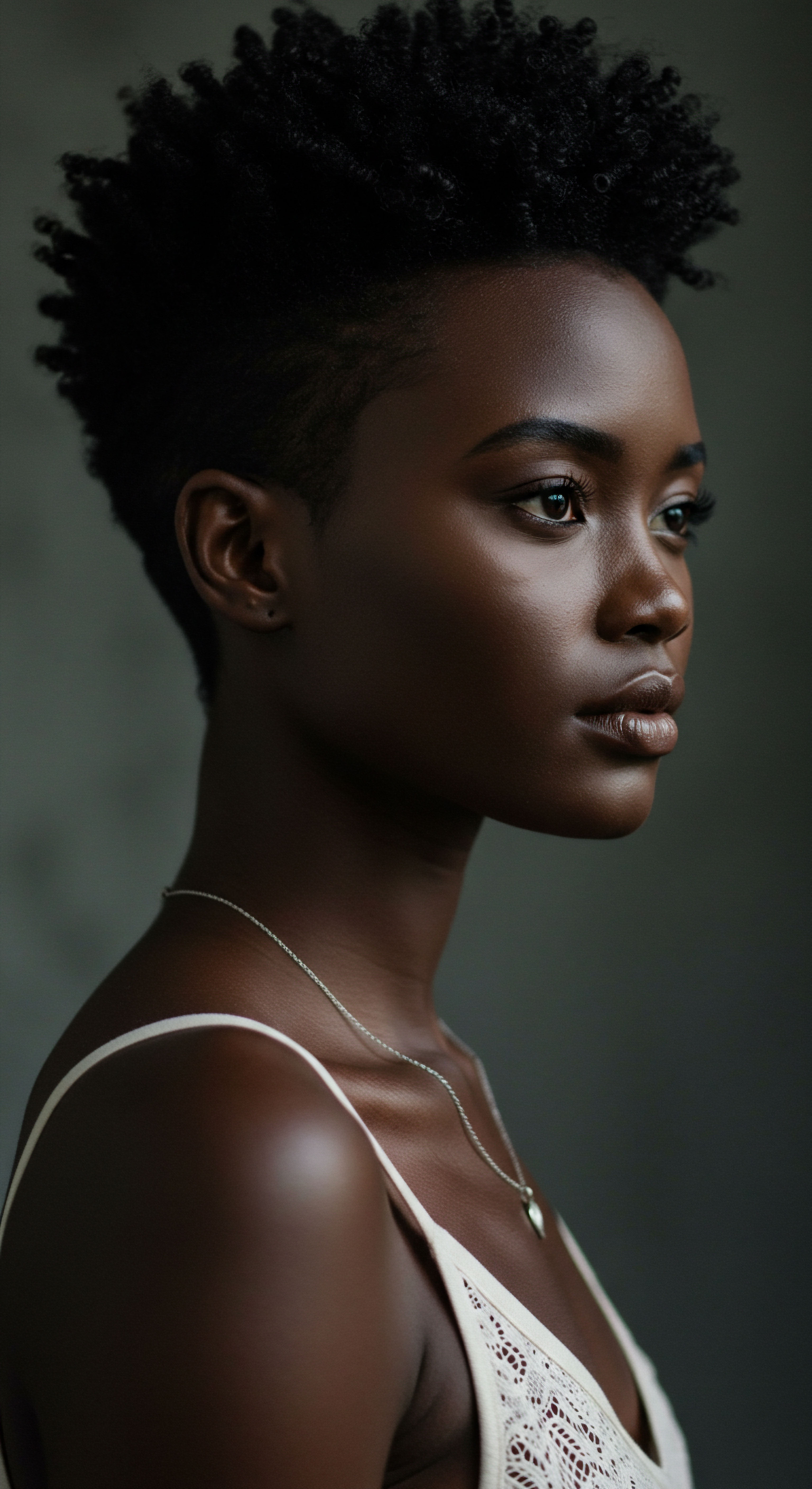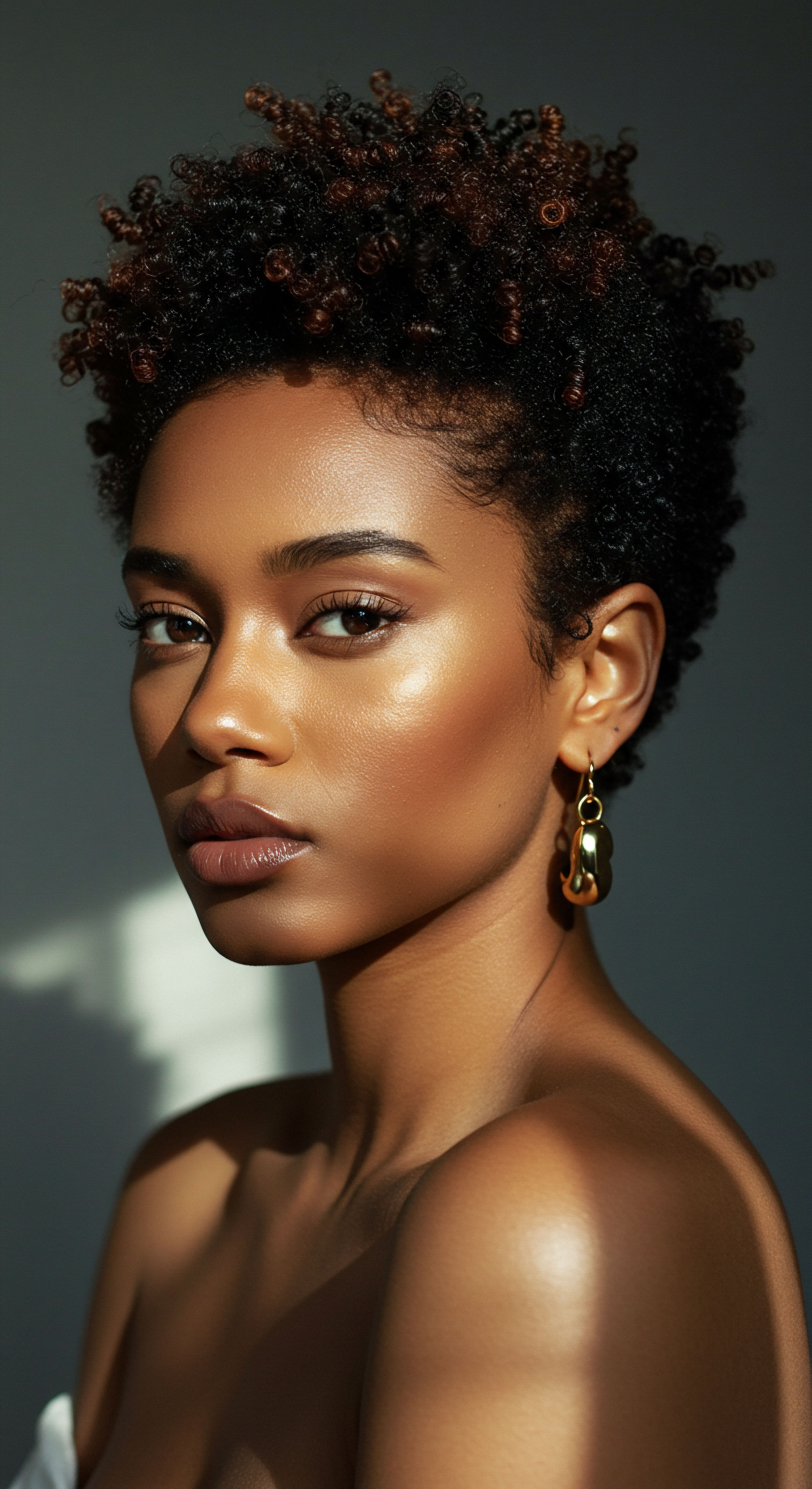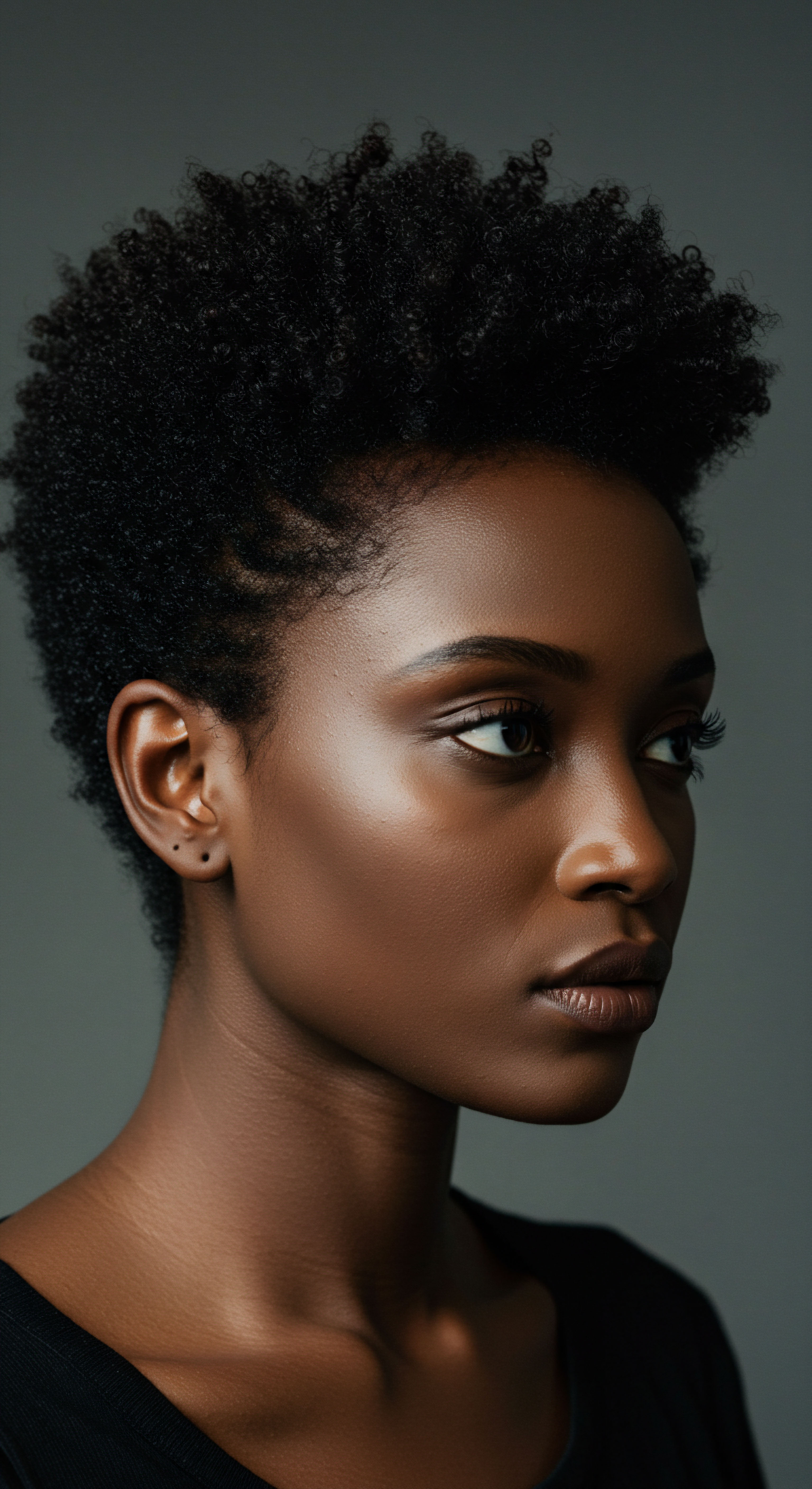
Roots
The quiet hum of life on our scalp, unseen yet ever-present, holds a delicate balance. We often consider the external world’s touch on our hair – the wind’s caress, the sun’s warmth, the gentle tug of a brush. Yet, a less visible, more intimate interaction occurs daily ❉ the subtle conversation between our chosen head coverings or pillow surfaces and the vibrant microbial community that resides upon our scalp. This dialogue, though silent, profoundly shapes the micro-environment where our strands begin their journey.
The scalp, a unique ecosystem, provides a home for a diverse collection of microorganisms, including bacteria, fungi, and archaea. This microscopic world, known as the scalp microbiome, operates in a careful equilibrium. When this balance is disrupted, conditions like dryness, itchiness, flaking, or even more persistent concerns can arise. Understanding how the materials we place against our scalp contribute to this dynamic system is a step towards cultivating an environment where our hair can truly flourish.

The Scalp’s Microclimate and Its Inhabitants
The scalp surface is not merely skin; it is a specialized habitat. It boasts a higher density of sebaceous glands compared to other skin areas, producing sebum – a natural oil that lubricates the hair and skin. Coupled with sweat glands and the insulating presence of hair itself, this creates a distinct microclimate ❉ a warm, often moist, and nutrient-rich expanse. These conditions are precisely what many microorganisms seek.
The dominant microbial residents on a healthy scalp typically include bacterial genera such as Cutibacterium and Staphylococcus, alongside fungal genera like Malassezia. These organisms usually coexist harmoniously, contributing to the scalp’s protective barrier and overall well-being. However, shifts in moisture, pH, or nutrient availability can alter this delicate arrangement, allowing certain populations to proliferate beyond their beneficial roles, potentially leading to discomfort or conditions like seborrheic dermatitis.
The scalp’s unseen microbial community, a blend of bacteria and fungi, lives in a delicate balance influenced by its unique microclimate.

How Fabric Properties Interact with Scalp Biology
The properties of textiles directly influence the skin’s microclimate by regulating moisture management, air permeability, and heat transfer. When a fabric rests against the scalp, it forms a barrier, trapping heat and moisture. Different materials handle these elements in varied ways, setting the stage for how the underlying microbial world responds.
For instance, highly absorbent materials might draw moisture from the scalp, potentially leading to dryness for some, while less absorbent ones could allow moisture to accumulate, creating a damp environment. The ability of a fabric to allow air to circulate also plays a part, influencing oxygen levels at the scalp surface. These seemingly small details contribute to a complex interplay, guiding the prosperity or decline of specific microbial residents.
- Material Composition ❉ Whether a fabric is derived from natural sources, such as cotton or silk, or from synthetic polymers, like polyester or satin, fundamentally alters its interaction with the scalp. Natural fibers often possess varying degrees of breathability and absorbency, while synthetics can be engineered for specific properties like moisture-wicking.
- Pore Structure ❉ The physical arrangement of a fabric’s fibers, how tightly or loosely they are formed, influences air circulation and moisture retention. A dense, non-porous material will create a more occlusive environment than a loose, open one.
- Surface Texture ❉ The smoothness or roughness of a material can affect friction against the hair and scalp, potentially causing irritation or even microscopic abrasions, which could then alter the skin barrier and influence microbial colonization.
The journey to understanding our scalp’s well-being begins with recognizing these foundational interactions. Every choice, from the softness of a pillowcase to the lightness of a head wrap, contributes to the story unfolding on our scalp.

Ritual
Stepping into the realm of daily practice, we consider the rituals that shape our textured hair care. From the soft bonnet donned at night to the casual head wrap worn throughout the day, these textile companions are more than mere accessories; they are silent partners in the ongoing conversation with our scalp’s unseen inhabitants. The practical choices we make about these materials hold a tangible influence on the very environment where our hair finds its strength and beauty. This section gently guides us through the practical wisdom of selecting and maintaining fabrics that honor our scalp’s delicate ecosystem.

Does the Fabric of Your Nighttime Covering Truly Alter Scalp Ecology?
Nighttime is a period of restoration for our bodies, and our scalp is no exception. For many with textured hair, a bonnet or scarf serves as a guardian, preserving moisture and preventing friction against pillow surfaces. Yet, the material of this guardian carries significant weight. Consider the common choice between cotton and silk or satin for sleep coverings and pillowcases.
Cotton, while a natural fiber, is highly absorbent. It readily draws moisture from hair and scalp, potentially leading to dryness over time for some individuals. This absorption extends to sebum and sweat, which can then accumulate within the fabric’s fibers. Over successive nights, this creates a warm, damp, nutrient-rich setting for microbial populations, potentially encouraging an overgrowth of certain bacteria or yeasts if not regularly cleaned.
Conversely, silk and satin, often favored for their smooth surfaces that reduce friction on delicate hair strands, are also less absorbent. This property helps the scalp and hair retain their natural moisture. By not soaking up scalp secretions as readily, these materials may present a less hospitable surface for microbial proliferation, particularly when maintained with consistent washing. The smooth texture of silk also reduces friction, which minimizes physical irritation to the scalp, preserving its barrier function that might otherwise be compromised and thus susceptible to microbial shifts.
| Fabric Type Cotton |
| Key Properties Highly absorbent, breathable, rougher surface |
| Potential Scalp Effect Can absorb scalp moisture and oils, potentially drying scalp; retains sweat/sebum, creating a warm, damp environment for microbes if not washed frequently. |
| Fabric Type Silk |
| Key Properties Smooth, less absorbent, breathable, naturally hypoallergenic |
| Potential Scalp Effect Helps retain scalp moisture; reduces friction; less likely to harbor oil/bacteria due to lower absorbency, contributing to a balanced environment. |
| Fabric Type Satin |
| Key Properties Smooth, less absorbent (often synthetic blends), reduces friction |
| Potential Scalp Effect Similar benefits to silk in moisture retention and friction reduction; composition (polyester/rayon) can influence breathability. |
| Fabric Type Polyester |
| Key Properties Moisture-wicking (athletic blends), can be less breathable in non-wicking forms, synthetic |
| Potential Scalp Effect Varies widely by specific weave; some can trap heat and moisture, others actively move it away, influencing microbial growth differently. |
| Fabric Type Understanding these properties guides choices for scalp well-being. |

How Can Regular Cleaning Routines Influence Scalp Health?
The cleanliness of our head coverings and pillowcases holds as much weight as the material itself. Regardless of whether one chooses cotton, silk, or satin, these textiles collect shed skin cells, sebum, sweat, and environmental particles. These substances provide a rich nutrient source for microorganisms. Regular washing removes these accumulations, preventing the establishment of dense microbial colonies that could alter the scalp’s delicate balance.
For instance, a pillowcase can gather scalp oil, creating a setting that attracts microscopic inhabitants like Demodex mites, which feed on sebum. While these mites are a natural part of the skin’s fauna, an overpopulation can sometimes contribute to irritation. A consistent washing routine, ideally once or twice a week for pillowcases and bonnets, disrupts this cycle, maintaining a cleaner surface against the scalp.
Regular washing of head coverings and pillowcases is a quiet act of care, preventing microbial overgrowth.
The temperature of the wash and the type of detergent also play a part. Hot water and certain detergents can effectively sanitize fabrics, reducing microbial load. However, harsher chemicals might leave residues that could irritate sensitive scalps, underscoring the need for a thoughtful approach to laundry. The aim is to cleanse the fabric without introducing new irritants to the scalp’s ecosystem.
The practice of allowing hair and scalp to dry completely before covering them for sleep is also noteworthy. A damp environment, particularly one that persists for hours, is a well-known invitation for microbial overgrowth, including various yeasts. This simple habit, alongside mindful fabric selection and diligent cleaning, supports a thriving scalp environment.

Relay
Our journey into the intricate world of scalp ecology deepens as we consider the less obvious, yet profound, ways fabric choices transmit signals to our scalp’s microbial residents. This section ventures beyond the surface, exploring the scientific underpinnings and subtle cultural nuances that shape this intimate interaction. We move into a space where the latest research sheds light on complex biological dialogues, inviting a more informed understanding of how the materials we choose become silent partners in our scalp’s long-term health.

Does Fabric’s Moisture Dynamics Directly Affect Scalp Microbiome Diversity?
The interplay between fabric and scalp moisture is a more sophisticated dance than simple absorption. It involves concepts of microclimate, vapor permeability, and the creation of specific environmental conditions that either suppress or encourage certain microbial populations. Research indicates that moisture management properties of textiles can directly influence the skin microclimate, which, in turn, alters microbial community structure. When a fabric traps excessive moisture against the scalp, it can lead to occlusion, a condition where the skin is covered and airflow is limited.
This occlusive environment can elevate the skin’s pH, compromising its natural barrier function. A higher pH can then favor the proliferation of less beneficial bacteria, such as certain species of Staphylococcus Aureus, which are associated with skin conditions.
Consider the case of Malassezia yeasts, common inhabitants of the scalp, which are lipophilic, meaning they thrive on oils. While a certain level of these yeasts is normal, an overgrowth is often linked to dandruff and seborrheic dermatitis. If a fabric creates a persistently damp and warm environment, particularly one rich in sebum, it can inadvertently provide an ideal breeding ground for these yeasts. Conversely, materials that wick moisture away efficiently, even synthetics, could theoretically reduce the dampness that these fungi prefer, thereby helping to maintain a more balanced microbial profile.
Fabric choices, through their moisture dynamics, can subtly shift the delicate balance of scalp microbes, influencing their composition and activity.
A study published in the journal Microbiologyopen investigated how short-term direct contact with various materials influences skin microbiota. While their focus was on soil and plant materials, they did examine exposure via fabric packets filled with moss material, finding that such contact increased, at least temporarily, the total diversity of skin microbiota. This suggests that the mere presence and properties of external materials in close contact with skin can indeed induce shifts in microbial diversity, a principle applicable to head coverings and pillowcases.
The surface hydrophobicity of a fabric also plays a part. Polyester, for instance, despite being synthetic, has a higher hydrophobicity compared to cotton, which can lead to it adhering more bacteria and absorbing more sebum. This might seem counterintuitive, but the research suggests that while polyester absorbs more sebum, it does not bind water as well as cotton.
The increased water content in cotton, even after drying, allowed some bacterial species to retain higher activity. This hints at a complex relationship where neither natural nor synthetic is unilaterally “better” for microbial balance; rather, it depends on the specific microbial species, the textile’s moisture-handling characteristics, and how frequently the textile is cleaned.

What Controversial Insights Does Research Offer on Fabric and Scalp Fungi?
While many narratives around scalp health emphasize the benefits of natural fibers, certain research offers a more nuanced, even challenging, perspective on their interaction with specific microbial populations. A Cornell University study, for example, highlighted cotton as a leading carrier of fungal spores, particularly Aspergillus Fungus, in hospital environments. The study found that cotton, with its irregular fiber shape, released significantly more spores than other smoother-surfaced fibers.
While this research focused on the spread of fungal spores in a clinical setting rather than direct scalp microbiome changes, it presents a thought-provoking parallel for head coverings. If cotton can harbor and disperse fungal spores more readily, it raises questions about its long-term use against the scalp, especially for individuals prone to fungal overgrowth or in humid climates.
This point becomes particularly compelling when considering the common scalp yeast, Malassezia, implicated in dandruff. If certain fabric properties, like moisture retention or surface morphology, contribute to a hospitable environment for fungal proliferation or dispersion, it challenges the simplistic notion that all natural fibers are inherently superior for scalp health. The ability of a fabric to quickly dry and not retain moisture, regardless of its origin, could be a more significant factor in managing fungal populations than its natural status alone.
Furthermore, research on the scalp microbiome of women wearing hijabs compared to those not wearing hijabs provides another lens. One study indicated that women wearing hijabs might be more prone to seborrheic dermatitis, with certain fungal species like Malassezia Restricta being more prominent in the hijab-wearing group. While this is a complex issue with multiple contributing factors (such as duration of wear, hygiene practices, and climate), the prolonged occlusion and altered microclimate created by head coverings are undoubtedly part of the equation. This suggests that the consistent presence of fabric, even if natural, can modify the scalp environment in ways that favor specific microbial shifts.
The selection of materials for head coverings and pillowcases, therefore, transcends simple comfort or aesthetic appeal. It becomes a strategic choice, influencing the very ecosystem that supports our hair’s vitality.
The implications for textured hair care are clear ❉ while traditional materials hold cultural weight and provide comfort, a deeper understanding of their biophysical interactions with the scalp allows for more informed choices. This perspective does not dismiss natural fibers but rather calls for a more discerning selection and maintenance, perhaps prioritizing quick-drying properties or incorporating specific washing regimens to mitigate potential microbial imbalances.
The continuous conversation between our chosen textiles and the microscopic world on our scalp is a testament to the interconnectedness of our environment and our personal well-being. Recognizing this intricate relationship empowers us to make choices that truly honor the delicate, living landscape of our scalp.

Reflection
The journey through the subtle interactions between our scalp’s microbial community and the fabrics we choose unveils a landscape far richer than simple comfort or visual appeal. It invites us to consider the quiet influence of daily habits and seemingly small decisions on the thriving ecosystem beneath our hair. This understanding deepens our appreciation for the delicate balance that governs scalp health, encouraging a mindful approach to the materials that touch our crowns. We are reminded that well-being, in its truest sense, extends to every hidden corner, prompting us to honor the living world that supports our strands.

References
- 1. Broadhead, R. Craeye, L. & Callewaert, C. (2021). The Future of Functional Clothing for an Improved Skin and Textile Microbiome Relationship. Microorganisms, 9(6), 1192.
- 2. Kind to Biome. (n.d.). Cross-industry Microbiome Exploration with SKIN SERIES and the Textile x Microbiome Relationship.
- 3. Gaunitz, W. (2022). Does Pillowcase Fabric Matter For Hair and Scalp Health? Advanced Trichology.
- 4. Lang, S. S. (2001). Cotton clothes found to be leading carrier of fungal spores, a scourge to some hospital patients with damaged immune systems. Cornell Chronicle .
- 5. Kim, J. & Kim, M. (2023). Scalp microbiome of healthy women wearing hijab compared to those not wearing hijab ❉ A cross-sectional study. International Journal of Dermatology, 62(10), 1261-1267.
- 6. Xu, Z. et al. (2018). Comparison of Healthy and Dandruff Scalp Microbiome Reveals the Role of Commensals in Scalp Health. Frontiers in Cellular and Infection Microbiology, 8, 345.
- 7. Townsend, N. Hazan, A. & Dell’Acqua, G. (2023). New Topicals to Support a Healthy Scalp While Preserving the Microbiome ❉ A Report of Clinical and in Vitro Studies. Journal of Clinical and Aesthetic Dermatology, 16(10 Suppl 1), S4–S11.
- 8. Pasanen, A. et al. (2019). Short-term direct contact with soil and plant materials leads to an immediate increase in diversity of skin microbiota. Microbiologyopen, 8(3), e00645.
- 9. Chen, Y. et al. (2022). Comparative analysis of scalp and gut microbiome in androgenetic alopecia ❉ A Korean cross-sectional study. Frontiers in Microbiology, 13, 1076242.
- 10. Park, Y. H. et al. (2017). Management of Scalp Biofilm in Local Dermatosis ❉ From In Vivo Visualization to Optimal Treatments. International Journal of Molecular Sciences, 24(10), 8683.
- 11. Callewaert, C. et al. (2020). The Bacterial Life Cycle in Textiles is Governed by Fiber Hydrophobicity. mBio, 11(2), e03273-19.
- 12. Hill, B. (2025). Satin vs. Silk Pillowcases for Hair ❉ What’s the Difference? Byrdie .
- 13. Sari, S. M. et al. (2023). Evaluation of Scalp Hydration and pH Values in Hijab-Wearing and Non-Hijab-Wearing Women. International Journal of Trichology, 15(5), 181-185.
- 14. Grimshaw, S. Xu, E. & Murphy, B. (2023). Scalp microbiome gets to the root of dandruff. Research Outreach, 141, 106-109.
- 15. Belledorm. (2024). Best Pillowcase Material for Healthy Hair ❉ Silk, Satin, and Sateen Options.